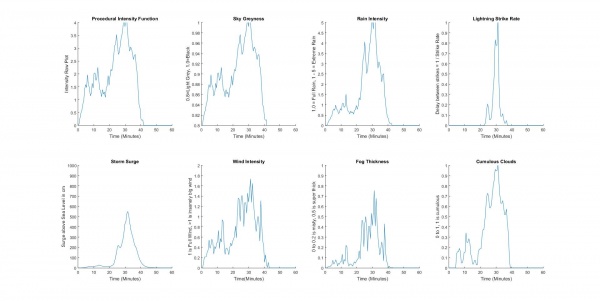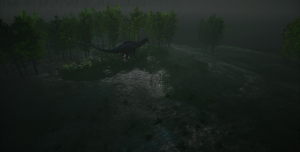Weather
A significant and antagonistic element of survival in Beasts of Bermuda is enduring the effects of storms. A development blog post was written on how storms are generated here. The weather generator in Beasts of Bermuda is capable of generating many different types of storms, with many different intensities and durations. The intensity of the storm along with its shape over time will dictate several different elements, being rain, storm surges, wind, and lightning. Due to the way in which it is programmed, almost any storm is possible, but some variants are significantly less probable than others. Many weather events will not be intense enough to cause significant threat to survival, often generating gentle or moderate amounts of rain with little to no storm surge present. Occasionally, however, a full-force hurricane will hit, presenting a very significant threat to survival.
The storm generator works essentially by throwing weighted dice every 36 seconds while the storm event is occurring. These dice dictate the storm's intensity profile, passing through four intervals of randomly determined duration. The tuning of the storm generator for creation in the UE4 engine was actually done using a MATLAB script with a wide array of parameters that determine many elements of the storm. A profile of a severe storm is shown on this wiki page, in which one can see all the different storm elements. Some of these elements are purely aesthetic, whereas others have gameplay repercussions.
The first stage of any generated storm is set up with a set of dice rolls that unanimously will increase the storm intensity. The amount of rolls is randomly determined. This ensures that no storm will peter out after only a few ticks of the storm clock, granting every storm a minimum threshold. Some storms will die immediately after this interval, causing weather events as short as 3 minutes.
In the second stage of the storm, the dice are biased towards increases in intensity but decreases are possible, thus allowing the moderately rare, super short storm to die here. As biased rolls of these dice accumulate, it is likely, but not guaranteed, that the storm will increase in intensity profile.
The third stage of the storm grants fair chance to the storm generator to increase or decrease in severity. In some instances, this may lead to continued increases in storm severity to ridiculous levels, often following suit with extreme storm surges that can flood significant sections of the game world. In other instances, the storm will die here, never making it to stage four. On average, the storm will stay relatively even in intensity profile. This stage of storm generation can vary in time duration from very brief, to rather long periods of time.
The fourth stage of the storm is marked by inevitable death. The storm will die, as in this stage with each cast of the dice that dictate the storm intensity profile, the likelihood of the roll coming out positive is lower and lower. A storm can occasionally resist stage four storm killing for a while, but eventually will be brought down.
It is also noteworthy to explain that the time duration between storms is also randomly dictated. Storms can strike nearly back to back, or significant time can pass between two storms.
Other weather events are likely to be created in Beasts of Bermuda as development continues. These may be droughts, dry-lighting storms, heat waves, or even tornadoes. Only time will tell how we advance the storm generator.
The storms pose a survival risk for players through many different weather elements explained in detail below.
During storms, players must seek shelter in order to prevent comfort loss and possible damage taken by lightning or tornadoes.
See also:Natural Disasters
Rain
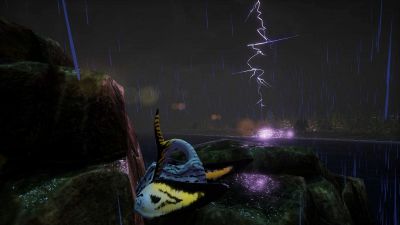
Of course, with a severe storm comes rain. The rain is one of two drivers of comfort loss during a storm, the other of which is wind. Rain is also the primary influence on storm surge intensity. A stronger rainstorm will bring a larger surge. Rain will significantly increase the rate at which sources of freshwater are replenishing, so in some instances of particular scarcity, a rainstorm can be welcomed by particularly thirsty players and dry lakes.
Storm Surges
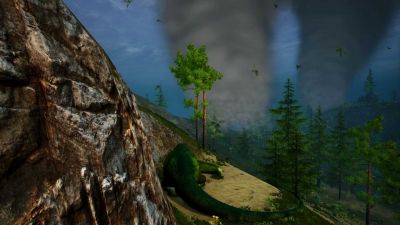
One of the most frightening elements of stormy weather in Beasts of Bermuda is the storm surge. The Ocean can creep up the beach, up the mountain, and even over the hills as it comes looking for victims during a particularly intense storm. The rising water level can pose significant threat to players in many different ways. First, being inundated by sea water will sharply drop the comfort level of any terrestrial creature. Rising water levels can also flush players out of caves and dens they may have taken refuge from, forcing them back out into the rain and further posting risk of death due to stress. These storm surges also set the stage for predatory aquatic creatures such as the Mosasaurus to take full advantage of the situation.
It takes a severe storm for a noticeable storm surge to take place. Surge accumulates as the integration of the square of the rain intensity over time, so the more intense and longer the storm, the higher the surge will climb. Very intense storms can cause frighteningly high surges to occur. Surges decay over time as well. The surge will usually recede with the lightening of the storm, but some particularly extreme storm surges have outlasted the storms that brought them.
Storm surges will sometimes very rarely flood significant fractions of the map, posing a significant survival challenge for terrestrial creatures. Due to the method in which the weather generator was coded, any surge is theoretically possible, and surges beyond 30 meters have been seen in-game on very rare occasion.
Lightning
Another risk associated with storms is death due to lightning strike. When the storm exceeds a certain threshold of intensity, lightning bolts will begin to periodically spawn around the map. The more intense the storm, the more frequent the lightning will occur. Lightning has a chance to target and deliberately strike an unsheltered player, so odds are if one decides to brave a particularly harsh storm, if stress doesn't kill you first, the lightning will. Creatures with weather resistance are less likely to be struck by lightning. The Apatosaurus is the only creature in-game that is capable of surviving a lightning strike. Lightning does not target aquatic creatures, regardless of whether they're sheltered, unless they are beached.
Wind
Wind is another factor that dictates the loss of comfort during a storm. It currently does not influence anything beyond comfort loss, but future effects on flying creatures is planned. Currently the game does keep track of and update a wind direction vector, which dictates the direction the rain drops and fog effects travel during a storm.
Fire
Forest fires are an extremely dangerous weather event recently re-added to the game. They spread quickly and could potentially apply deadly debuffs to one's creature. Even just being right next to a fire can significantly injure the player, so fires should be avoided!
Fires are started in one of three ways:
- Dry lightning. This weather event frequently spawns very aggressive forest fires, but due to the rarity of dry lightning itself, this is fairly uncommon.
- Thunderstorms frequently spawn smaller, localized forest fires. However, rain dampens the speed and spread of the fires significantly.
- Long periods of time without rain will grant the chance for drought fires to spawn, which are very dangerous and spread rapidly.
When a fire spawns, its dangers do not immediately kick into effect. Rather, there is a 10-second grace period between spawn and activation, allowing players a window to escape should fire spawn in extremely close proximity to them. Fires produce columns of smoke, which - in most cases - can be seen across whatever map they may be present on. This allows the player to locate and avoid fires from a considerable distance.
Tornadoes
Tornadoes are generated during intense storms. They will pick up all players, with the exception of adult Apatosaurus, and chuck them across the map. Tornadoes will track any player not in a cave. Tornadoes tend to track the largest concentration of unsheltered players on the server.
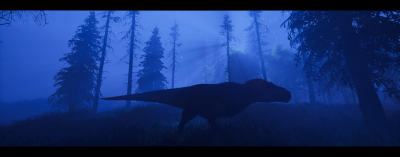
Droughts
Droughts are a future weather event the developers plan to add to the game. It will involve water levels going down substantially, forcing players to find dwindling pools of water to drink from.
